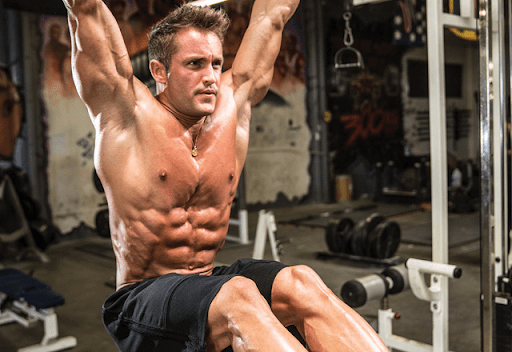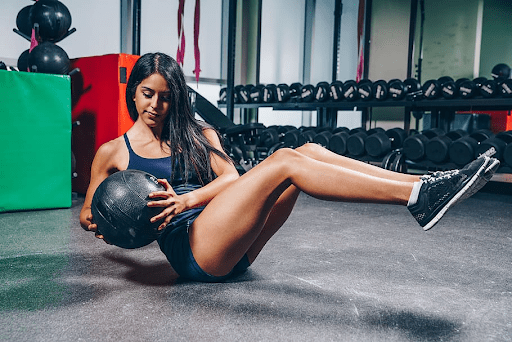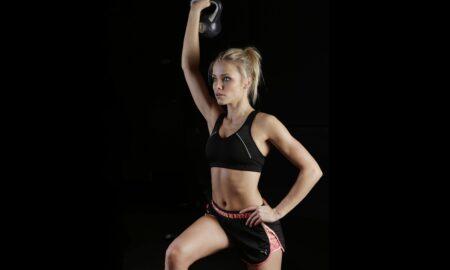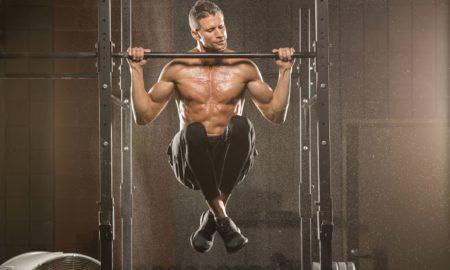

A strong, chiseled midsection with well-defined abs is a fitness goal that many aspire to achieve. Beyond the aesthetics, a strong core offers many benefits, from improved posture and reduced risk of injury to enhanced athletic performance and functional fitness.
However, building a solid midsection requires a focused approach that combines targeted core workouts, proper nutrition, and a commitment to overall fitness.
This article will explore the benefits of chiseled abs, building a shredded core, and workouts that effectively develop strong abs. Each exercise will be accompanied by an explanation of the specific muscles targeted and detailed instructions on how to perform them correctly.
What Makes Up the Core
Most individuals do not grasp which muscles comprise the core. As a result, many do the wrong exercises thinking they are working out the core when they are not.
The core muscles are a group of muscles that make up the central part of the body and provide stability and support for the spine and pelvis. The primary muscles that comprise the core include:
Rectus Abdominis is the “six-pack” muscle that runs vertically along the front of the abdomen. It acts as a natural corset, providing stability and supporting the internal organs.
Transversus Abdominis lies deep within the core, beneath the rectus abdominis. It is involved in movement and spine stabilization.
Internal and External Obliques muscles are located on the sides of the abdomen, with fibers running diagonally. They help to rotate and protect the spine.
Diaphragm is situated below the chest. Although not commonly considered a core muscle, the diaphragm is crucial in core stability and breathing. It contracts and flattens when inhaling and exhaling to help you with breathing. Diaphragm has small openings that transport blood to the heart and digestive function.
Pelvic Floor Muscles include the bladder, intestines, vagina, rectum, cervix, urethra, uterus, and connective tissues like hip flexors, hamstring, and abductors. These muscles form a sling-like structure at the bottom of the pelvis and help to support the pelvic organs and maintain bladder and bowel control.
Benefits of Having Strong Abs or Core
Having strong abs offers several benefits in terms of physical health and overall well-being. Here are some critical advantages:
Enhanced Stability and Balance
Imbalance is a common problem many people experience, especially as they age or engage in activities that require stability.
The strong core muscles, including the abdominal and back muscles, stabilize the spine and pelvis. When these muscles are strong, they provide a solid foundation for the rest of the body, helping to maintain balance and prevent falls during movements, such as walking, running, or performing exercises that require stability, like weightlifting or yoga.
For healthy individuals with a history of hip or leg injuries, you want to incorporate core strengthening exercises into their training programs to overcome core stability deficits.
The core muscles also play a vital role in coordinating movements between the upper and lower body, enhancing overall balance.
Improved Athletic Performance
Many athletes struggle with suboptimal performance and limited efficiency in their chosen sport. They may find it challenging to generate power, maintain balance, or execute precise movements, ultimately hindering their performance.
A strong core provides a stable foundation for movement. It lets you retain balance and control during dynamic actions, such as changing directions, landing from jumps, or performing rapid exercises.
A strong core also allows efficient force transfer generated by the legs and hips to the upper body and vice versa. This generation and transfer of power maximize your performance potential in sports that involve explosive movements like sprinting.
Injury Prevention
A strong core helps stabilize the spine, reducing excessive stress on the back and other vulnerable areas.
Strong core muscles also help with proper body mechanics and lifting techniques, reducing the likelihood of injuries such as strains and sprains during daily tasks or physical activities.
Better Breathing and Digestion
The diaphragm, a primary muscle involved in respiration, is part of the core. Strengthening the core muscles, including the diaphragm, can improve breathing mechanics and lung capacity.
Additionally, strong core muscles aid in supporting and stabilizing the organs involved in digestion, potentially improving digestive function.
Reduced Risk of Back Pain
Pain in the lower back is a common complaint and can significantly affect a person’s quality of life. This study shows more than half of Americans suffer from back pain.
When the core muscles are weak, they fail to provide adequate support to the spine, leading to increased stress on the back muscles, ligaments, and discs. This can result in muscle imbalances, improper posture, and spinal misalignment, all contributing to back pain.
Strong core muscles work together to maintain proper alignment and reduce excessive strain on the back. They also distribute the load evenly and protect the spine during movements and activities, minimizing the risk of injury and back pain.
How to Get Abs

Getting visible abs involves a combination of workouts, a clean diet, and a recovery period to reduce body fat and develop the underlying abdominal muscles.
Workouts to Get Abs
Different exercises exist, but not all can help you develop a shredded core and help you achieve your six-pack fitness goal.
To develop chisel abs, incorporate strength training exercises like squats, deadlifts, lunges, push-ups, planks, Russian twists, and leg raises.
Regular cardiovascular exercises such as running, swimming, cycling, or HIIT (high-intensity interval training) can also help burn calories, boost metabolism, and enhance abdominal fat loss, leading to chiseled abs.
Below are six strategic abs workouts to help you build a strong core.
1. Plank
Planks target Rectus Abdominis, Transverse Abdominis, Internal and External Obliques, Erector Spinae, and Multifidus.
How to Do:
- Start in a push-up position with your hands directly under your shoulders.
- Engage your core muscles and keep your body straight from head to heels.
- Hold the position for a specific duration, starting with 30 seconds and gradually increasing. Repeat for multiple sets.
2. Russian Twists
Russian twists target the internal and external obliques, rectus abdominis, and transverse abdominis.
The workout strengthens the oblique muscles and improves rotational stability. Russian twists also engage the deep core muscles responsible for spinal stabilization.
How to Do:
- Sit on the ground with your knees bent and feet flat on the floor, slightly elevated if possible.
- Lean back slightly while keeping your back straight to form a V-shape with your torso and legs and engaging your core muscles.
- Keeping your legs stationary, clasp your hands together in front of your chest and twist your torso to the right, touching your hands to the ground beside your hip.
- Twist your torso to the left, touching your hands to the ground beside your left hip. Continue alternating sides for a specific number of repetitions or duration.
3. Hanging Leg Raises
Hanging leg raises effectively target the lower abs and hip flexors, improve core stability, and enhance shredded abs.
How to Do:
- Hang from a pull-up bar or any sturdy overhead structure with extended arms.
- Engage your core, lift your legs, and bring your knees to your chest.
- Slowly lower your legs, maintaining control throughout the movement.
- Aim for 10 to 12 repetitions, gradually increasing as you build strength. If this is too challenging, you can modify the exercise by bending your knees and performing knee raises instead.
4. Bicycle Crunches
Bicycle crunches effectively engage the abdominal muscles, particularly the obliques. They also work the hip flexors and enhance upper and lower body coordination.
How to Do:
- Lie flat on your back with your hands gently supporting your head, elbows out to the sides.
- Lift your legs off the ground and bend your knees at a 90-degree angle.
- Lift your shoulder blades off the ground and bring your right elbow towards your left knee while extending your right leg straight.
- Switch sides by bringing your left elbow towards your right knee while extending your left leg straight.
- Continue alternating sides in a pedaling motion for a specific number of repetitions or duration.
5. Mountain Climbers
Mountain climbers are dynamic exercises that simultaneously engage multiple muscles. They primarily target the rectus abdominis, transverse abdominis, obliques, hip flexors, and shoulders.
They help to strengthen the core muscles, improve cardiovascular fitness, and enhance coordination and agility. Additionally, mountain climbers can increase overall calorie burn and contribute to fat loss leading to visible six-packs.
How to Do:
- Start in a high plank position with your hands directly under your shoulders. Ensure your back is straight and your body is in a straight line from head to toe.
- Engage your core muscles and bring your right knee towards your chest, then quickly switch and bring your left knee towards your chest.
- Continue alternating knees in a running motion while maintaining a straight back and engaged core.
- Perform for a specific number of repetitions or duration, maintaining a controlled and steady pace.
6. Front Squats
Front squats are a compound exercise that engages your core muscles for stability and support. The exercise primarily targets the rectus abdominis, transverse abdominis, obliques, quadriceps, glutes, and lower back muscles.
How to Do:
- Stand with your feet shoulder-width apart, holding a barbell across the front of your shoulders, elbows pointing forward, and upper arms parallel to the ground.
Alternatively, you can use dumbbells or a kettlebell held in a goblet position.
- Engage your core muscles, keep your chest up, and maintain a neutral spine throughout the movement.
- Initiate the squat by pushing your hips back and bending your knees, maintaining the weight in your heels and your knees tracking over your toes.
- Descend until your thighs are parallel to the floor or slightly below while maintaining proper form.
- Drive through your heels and extend your hips and knees, returning to the starting position.
Repeat the movement for the desired number of repetitions, aiming for 8-12 reps per set.

Clean Diet
Focus on consuming nutrient-dense foods, including lean proteins, whole grains, fruits, vegetables, and healthy fats.
Protein
Protein is the most valuable macronutrient your body requires when building shredded abs, as it is the building block of muscle.
Protein has a higher thermic effect compared to carbohydrates or fats. This means the body expends more energy (calories) to digest and process protein. This increased calorie expenditure during digestion contributes to overall calorie burn and potentially aids in reducing body fat, including the fat covering the abdominal muscles, leading to the chiseled core.
Some lean protein sources include chicken breast, fish, tofu, eggs, turkey legumes, and low-fat dairy products.
Post-Workout Carbs
Consuming natural carbohydrates, especially after working out, can help you develop a shredded core.
Post-workout carbohydrates help initiate recovery after an intense workout by replenishing glycogen stores. It also provides a readily available energy source for your next workout, allowing you to perform at your best. Natural carbohydrates include the following:
- Fruits: apples, bananas, oranges, berries, and melons.
- Vegetables: broccoli, spinach, kale, carrots, and bell peppers
- Whole Grains: brown rice, quinoa, oats, barley, and whole wheat.
- Legumes: lentils, chickpeas, black beans, kidney beans, and peas
- Tubers and Root Vegetables: sweet potatoes, yams, and beets.
- Dairy Products include milk, yogurt, and kefir.
Healthy Fats
Also, include healthy fats such as monounsaturated and polyunsaturated fats into your well-balanced nutrition plan.
Healthy fats are more satiating than refined carbs. They keep you fuller for longer, aiding in controlling overall calorie intake, which is crucial for reducing body fat and revealing six-pack abs.
Healthy fats include avocado oil, nuts, seeds, olive oil, and fish oil.
Conclusion
Developing chiseled abs and a muscular midsection requires a combination of targeted exercises, proper nutrition, and overall body fat reduction.
While these core workouts will play a significant role, it’s essential to maintain a well-rounded fitness routine that includes cardiovascular exercise, full-body strength training, and a balanced diet to maximize results.






















You must be logged in to post a comment Login